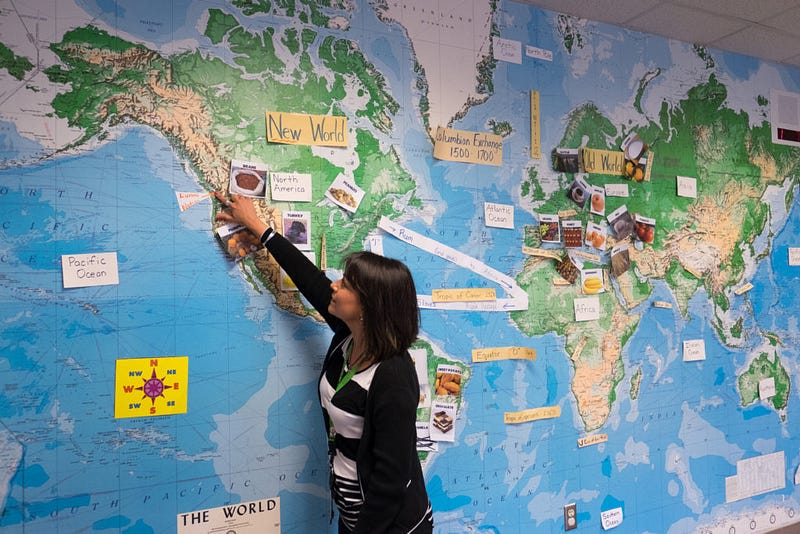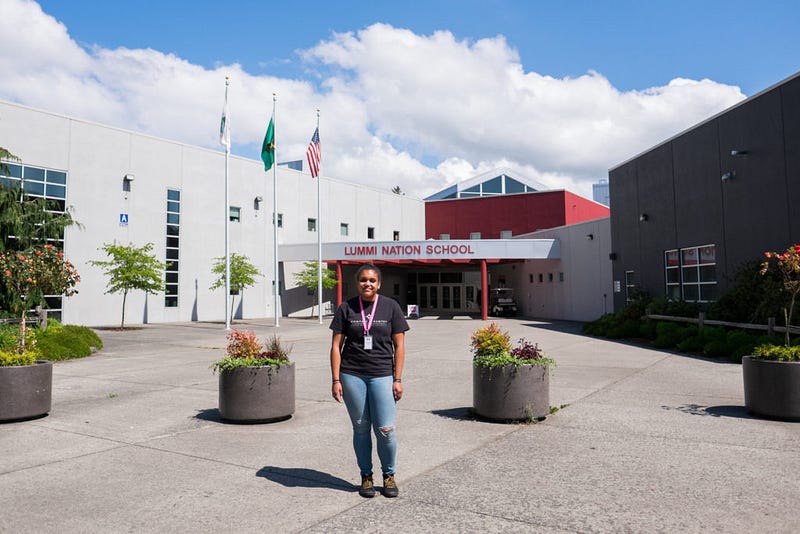Suppressed but not forgotten
As a descendent of the S’Klallam Tribe, I reconnect to my Native roots
STORY BY MONEA KERR | PHOTOS BY JAKE TULL
(Above) The k-12 Lummi Nation School is one of eight tribal schools of the 29 federally recognized tribes in Washington.
I never identified the Native American aspect of my culture as something to be proud of.
Growing up as a multi-racial girl with a Native American mom who sports blonde hair and blue eyes, you could say I was a bit confused. I knew that I was a blend of black, white and Native American, but felt like I was always confined to the box titled “other.”
I am a descendent of the Jamestown S’Klallam Tribe that once prospered along the entirety of the Olympic Peninsula but now resides in Sequim, Washington. The word S’Klallam means “the strong people.”
I grew up in Mountlake Terrace, Washington, in the suburbs of Seattle. We would spend weekends in Sequim at what my family called the beach house: a bright yellow two-bedroom trailer with great character and a killer view of the ocean.
My cousins and I would venture along the shore, playing on the logs that washed up each night. I loved playing on the beach, but never imagined what it looked like 50 years ago.
Jamestown Road shares the shore with the Pacific Ocean. During World War II, the native residents along this stretch of land lived in fear of enemy ships and submarines. My ancestors fought for their land and they are the reason I can play on the beach to this day.
My favorite time of year as a child was during the summer when the tribe would hold a picnic with an all you could eat smorgasbord of oysters, clams and salmon. I never thought about the generations of practices and tradition which brought the seafood to my plate.
Now a decade and a half later I sit on the same beach, watching the seaweed-filled water as it crashes onto the rocky shore. My confusion has turned to curiosity. I wonder what it was about my heritage that made me set it aside like a paper I didn’t want to write for nearly my whole life.
It never dawned on me that maybe I didn’t know about my culture because I wasn’t taught about it. That maybe it never crossed my mind because my people were never mentioned in the textbooks that I was required to read.
The victors glorified in American history were all white, my teachers were white and people in the media were white. How does a mixed girl navigate in this world?
My grandmother told me a story recently that sent a shock through my whole being. My great-great grandpa, the one who possesses my Native roots, married his wife because she was white. He wanted the generations after him to look less Native and move through society with more ease. Now I understand why my mother’s side has skin that is such a contrasting color to my own.
The mixing of ethnicities to create a “whiter” family was a prominent idea in the 30s. Native attributes were pushed as far away as possible to make life easier for future generations.
I didn’t realize how the teaching of Native cultures would work in a school environment until I had my first day working at Lummi Nation School. Of the 29 federally recognized tribes in Washington, eight have tribal schools. Lummi Nation K-12 on the Lummi Nation Reservation is one of them.
I was first introduced to Lummi Nation School through my position as a lead mentor for Western’s Compass 2 Campus program. Compass 2 Campus is a pilot initiative, which trains university students to be mentors for youth in the surrounding elementary, middle and high schools.
As a freshman at Western I never learned that the university resides on what was once Lummi land. Right across Bellingham Bay is the Lummi Nation Reservation, marginalized to just a fraction of the land that they once inhabited.
I wonder how many people know that just a half-hour drive will lead you to the preservation of a culture that has become invisible. A culture that relies heavily on the sea for food and canoeing, which has a strong commitment to family and their elders. A self-governing nation within a nation.
My first quarter working at Lummi I was terrified. I heard horror stories about students with attitudes who drove mentors to tears. I dreaded what I might find. This fear dissolved the moment I arrived and was welcomed by the students and staff. After a couple of months I became a staple in the school community.
SCHELANGEN — THE LUMMI WAY OF LIFE
“Oooay,” the sound of singing fills the room and any surrounding corridors. A group of 15 students, from grades 7 to 12, gather to practice song and dance in the music room of Lummi Nation School.
Inherited and passed down generations from ancestors long passed, the BOOM of the rawhide drum echoes and makes the walls shake. A handful of the students are gathered in the middle of the room, stomping to the beat and taking wide steps to the right, swooshing their shoulders down to the echoes of chanting resonating in the room.
This is one way the Schelangen, or Lummi way of life, is embedded in the school. Here students practice their Native language, partake in Native song and dance and learn about their history through a Native lens.
Working in an environment that valued the Native experience was new to me. Their faces lit up at any mention of their native roots. Once I saw how embedded the native culture was in the school, I finally began to appreciate my own.
The dropout rate for Native Americans in Washington in 2013 was 25.5 percent, which is the highest among any race, according to the Office of Native Education. Teachers at tribal schools like Lummi’s work to combat this statistic each year.
In the seventh grade history class taught by Jessica Lafortune students compared and contrasted coastal and plateau tribes. Learning about the different areas of Washington and the customs and traditions of the tribes that inhabited them was new and exciting for us. I never learned anything like this when I was in middle school.
Lafortune was one of the first teachers I met at Lummi Nation School. Her enthusiasm and passion for teaching inspired me.
She refuses to let any of her students pass through the education system unnoticed. In her two years of teaching at Lummi Nation School she has built a reputation for herself.

Lafortune’s class is a safe haven for many students. She invites them to eat lunch with her in her room and has many visitors during each passing period. Her demeanor with the students lets them know that she cares not only for their academic success but also for their emotional wellbeing.
Students at Lummi Nation School often come from a difficult home life. Lafortune does whatever she can to ease part of the stress that her students bring with them to school.
She was hired the day before the start of the 2014–15 school year, without warning about the challenges of working at a tribal school.
Building trust at Lummi Nation School takes time. The students there have experienced the consequences of oppression firsthand, and don’t find it easy to trust outsiders. The students later confessed to Lafortune that they used to go out in the hallway and plan what trick they would play on her every day during that first year.
“I’m extremely tough and I’m a survivor,” she says. “But the first three months I think I cried every day.”
For the first time, Lafortune considered quitting and she doubted if teaching was what she was destined to do. Then she said a miracle happened.
“When they realized they couldn’t make me leave them, reject them and abandon them like they expected me to because all of the other adults in their lives did… then they loved me and I’m like their mom now,” she says.
Often it’s hard to get the students at Lummi excited to do their schoolwork but has learned that perseverance is key. These students respond well to consistency and people who make learning fun.
When students leave for summer, Lafortune hopes that they remember one thing: to aim high. If they can understand that they have at least one person in their lives that believes in them, despite all of the factors of oppression that they face daily, they will believe in themselves too.
Working with these students also allows me to believe in myself. After spending time at Lummi, I became more comfortable learning and talking about my Native American roots.

5.2 million people in the U.S. identified as American Indian and Alaska Native in 2010 either in combination with other races or alone, according to the U.S. Census Bureau. This marked a 39 percent increase in Native American identification since 2000, according to the US Census Bureau.
Now being Native is celebrated and recognized as something to be proud of. No longer do Native Americans need to feel ashamed of their culture. And as the number of Native American students entering national education rises each year more states are looking to include the narratives and history of tribes.
The Tribal Sovereignty Curriculum was created in order to educate against myths and common misrepresentations about Native American people, according to the Office for Native Education. If Native students see their history and culture accurately represented in school, they will be more invested in their education as a whole.
The Office of Superintendent of Public Instruction in partnership with the 29 federally recognized tribes in Washington State created the curriculum initiative, titled “Since Time Immemorial.” The curriculum includes tribal history, law and issues on both a national and local scale and varies between elementary, middle and high schools. The 2015 Washington State Legislature made it a requirement to incorporate the curriculum in K-12 social studies through Washington’s Basic Education Act.
My grandmother moved back to the beach house in Sequim about the same time I started mentoring at Lummi. She too had pushed herself away from our culture and strived to regain some of what she missed. She has taken up traditional beading, basket weaving and canning; ancient trades she never learned and hopes will help her to make up for time lost.
My only regret is putting aside my heritage for as long as I did. I am fortunate that despite this, there are still people of my tribe and the other tribes in Washington that are around to tell the tales that I was unaware of for so long.